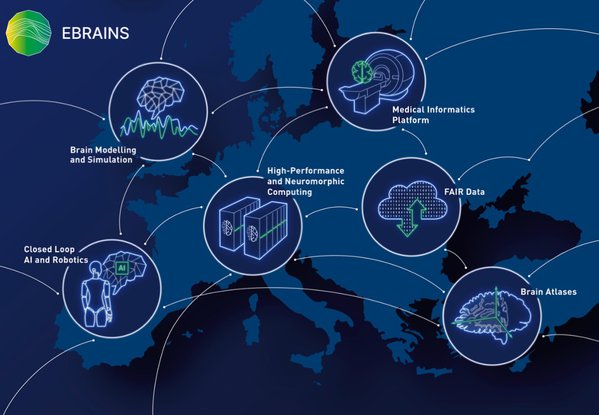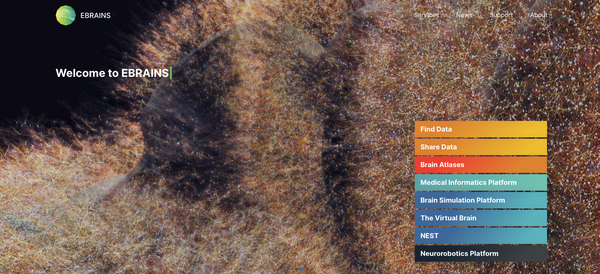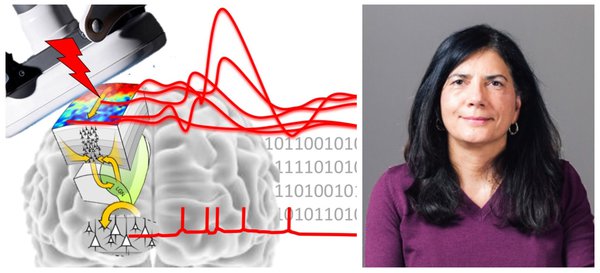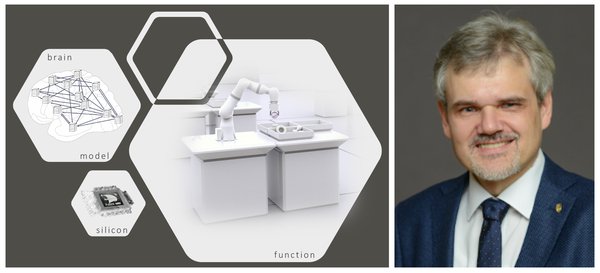Human Brain Project announces new phase
29 June 2020
- The HBP presents its pioneering new Infrastructure EBRAINS to jumpstart a new era in neuroscience
- The HBP is targeting brain networks, their role in consciousness, and artificial neural nets
- European Commission funds the project with 150 million Euros from now until 2023
The Human Brain Project (HBP) announces the start of its final phase as an EU-funded FET Flagship. The European Commission has signed a grant agreement to fund the HBP with 150 million Euros from now until 2023. Over the next three years, the project will narrow its focus to advance three core scientific areas – brain networks, their role in consciousness, and artificial neural nets – while expanding its innovative EBRAINS infrastructure. EBRAINS offers the most comprehensive atlas and database on the human brain, directly coupled with powerful computing and simulation tools, to research communities around neuroscience, medicine and technology. Currently transitioning into a sustainable infrastructure, EBRAINS will remain available to the scientific community, as a lasting contribution of the HBP to global scientific progress.
Supercomputers, Big Data Analytics, Simulation, Robots and AI have all become new additions to the “toolbox” of modern neuroscience – a development strongly pushed forward by the HBP and its EBRAINS infrastructure.
Started in 2013 as a FET Flagship project, the HBP is the largest brain science project in Europe. Now entering the final phase of its ten-year lifespan, the project is proud to present its scientific workplan and transformative technological offerings for brain research and brain-inspired research and development.

Overview of the digital EBRAINS research infrastructure with its offers for science and industry.

All services are made available via the web platform www.ebrains.eu
HBP’s scientific activities in the new phase focus on three topics: networks that are studied across different spatial and temporal scales, their significance for consciousness and disorders of consciousness, and the development of artificial neural networks and neurorobotics.
These topics will be developed hand in hand with the EBRAINS research infrastructure. Likewise, a growing community of external users and partnering projects, researchers working on a range of neuroscientific questions increasingly benefit from the diverse methods that are seamlessly integrated in EBRAINS.

Prof. Katrin Amunts, HBP Scientific Research Director. © FZ Jülich / Sascha Kreklau
“We will make the infrastructure more efficient, attractive and user-friendly”, says HBP Scientific Research Director Prof. Katrin Amunts. Researchers and engineers are working closely together on this, ‘co-designing’ technical solutions that fit the science needs perfectly. This creates a win-win situation for both communities, Amunts says.
Following this approach, research into the functioning of the human brain and its diseases flowed into constructing novel digital tools for a data-driven, interdisciplinary and collaborative approach. "We needed a broad spectrum of neuroscientific fields to do justice to the complexity of the brain, and permanent coordination with the engineers and developers to be able to handle the enormous amounts of data involved, bridging the scales of brain organization from the molecular level to the whole organ.” Much has been achieved in this way, reflected in over 1200 scientific publications to date and a rapidly growing number of users and partners.
EBRAINS today already provides researchers with a wide spectrum of unique services, resources and technologies, for example, a multi-level human brain atlas, which is navigable in 3D, linked to a growing neuroscientific data base, as well as access to a federated system of most powerful European supercomputers, and brain-inspired "neuromorphic" computers pushing simulation and deep learning analytics to new horizons.
An increasing number of applications are built one these new technologies. A method for personalized modelling of patient brains is currently undergoing clinical trials, the first of its kind. The EBRAINS "Medical Informatics Platform" has been installed in 30 European clinics, enabling to run analysis of patient data, without the highly sensitive information having to leave the hospital. It is expected that this technology will have an impact for future studies of rare diseases.
To help the HBP achieve its goals on both the scientific and infrastructure side, the consortium will be further opened during the new phase. New talent will be brought in through a series of Calls for Expression of Interest.
Putting EBRAINS on the European map
On the institutional side, decisive steps are being taken to ensure the infrastructure reaches its operational maturity after the end of the HBP. In 2019, the EBRAINS AISBL, an international non-profit association under Belgian law, was founded in Brussels with the objective of promoting and supporting brain research. In the coming months, the EBRAINS AISBL will take over the role of the coordinator of the HBP from the Swiss Ecole polytechnique fédérale de Lausanne (EPFL).
An experienced expert on EU research issues from within the European Commission was recruited as founding CEO of EBRAINS and new Director General of the Human Brain Project. Paweł Świeboda joined in May 2020 from his post as Deputy Director and Head of Research at the European Political Strategy Centre, the advisory hub to the Commission President. "EBRAINS is a state-of-the-art digital infrastructure that will be instrumental to secure Europe's place globally in the dynamically growing field of multidisciplinary brain research, with powerful implications for AI, neurorobotics and medicine," Świeboda said.

Paweł Świeboda, EBRAINS CEO and Director General of the Human Brain Project
For the European Research landscape, the HBP has helped to establish a focal point connecting the distributed expertise and resources across the EU: From Germany, for example, world-leading groups come from human brain atlasing, neuromorphic computers, simulation and high-performance computing. France contributes to the project its special expertise in personalized brain models of patients and neuroimaging, Belgium expertise in clinical neuroscience, Norway and Greece in data management, Switzerland in nerve cell simulation, and the Netherlands in linking neurotechnology and cognitive science. "All these groups are working together through the HBP and EBRAINS, creating outcomes together that would have been unthinkable on their own," says Świeboda.
A key objective for the next three years will be to further integrate EBRAINS into the European and global research landscape and to implement new projects with external scientific users. Partnerships with the European Brain Council (EBC) and the project European Research Area for Neurosciences (EBRA), which foster cooperation and convergence between the various activities in Europe, will contribute to this goal. "In this concept, EBRAINS provides the technical platform to facilitate cross-national cooperation and enable faster progress for the benefit of society," says Katrin Amunts.
Contact:
k.amunts@fz-juelich.de pawel.swieboda@ebrains.eu
HBP Public Relations:
press@humanbrainproject.eu
Further information:
https://ebrains.eu
https://www.humanbrainproject.eu
Workpackage Overview - Science
WP 1 - The human multiscale brain connectome and its variability – from synapses to large-scale networks and function

© INS © V. Jirsa
Leader: Prof. Viktor Jirsa, University of Marseille
viktor.jirsa@univ-amu.fr
This work package develops biologically detailed human brain network models capable of generating brain signals as commonly measured in clinical and research settings. By linking a multiscale human brain atlas to computational modeling, the aim is to better understand the fundamental mechanisms of how the brain generates its behavior. The validity of the principles and concepts is demonstrated in applications to individual patient data for clinical translation such as in epilepsy, and in cohort data to understand human variability such as in healthy aging and pathology. Neuroethical interrogations guide the debate on the role of the digital twin brain in society.
Includes
- World’s most detailed human brain atlas (20μm)
- Personalization of brain network models
- Technology used for world’s first clinical trial in epilepsy surgery
- Neuroethics debate on the role of a digital twin brain
WP 2 - Networks underlying brain cognition and consciousness

© Sameer Kishore
Leader: Prof. Mavi Sanchez-Vives, IDIBAPS, Barcelona, Spain
msanche3@clinic.cat
Our brain is a complex network of neurons able to perform very different activities, from a large variety of high-level cognitive functions, to sleep. To improve our understanding of how these processes occur, WP2 will generate data-driven models that carry out cognitive tasks – such as object recognition or decision-making-, while expressing realistic brain dynamics in different states (sleep, awake, anesthesia, etc). This challenging objective requires the coordinated work of a large number of experimental and computational research groups, and the results will help to understand not only the healthy brain but also the brain in pathological conditions. The resulting data and models will be made available to the community.
WP 3 - Adaptive networks for cognitive architectures: from advanced learning to neurorobotics and neuromorphic applications

Leader: Rainer Goebel, Professor for Cognitive Neuroscience at Maastricht University, Netherlands.
r.goebel@maastrichtuniversity.nl
At the interface of neuroscience, AI and robotics, this work package develops biologically inspired, embodied, large-scale neural models emulating a range of brain functions. The aim of this approach is, by (re-)creating these functions, to better understand how neural activity enables perception, cognition and action. The advanced learning principles developed to support this work are applied to train deep networks, solving challenging tasks on neuromorphic hardware. Insights gathered are applied to improve the manner in which artificial agents understand and act upon their environment.
Workpackage Overview - Infrastructure
WP 4 - EBRAINS Data Services

Leader: Prof. Jan Bjaalie, University of Oslo
j.g.bjaalie@medisin.uio.no
Finding, accessing, interpreting, and making use of high-quality neuroscience data beyond the level of the traditional journal publication will be key for the future of neuroscience and modelling of the brain. The Workpackage and its High-Level Support Team (HLST) provide the broader neuroscience community with services to organize, manage, visualize, analyse, interpret and share multi-level and multi-modal research data and computational models, in accordance to FAIR data standards. Powerful and unique resources are offered to researchers, including:
- EBRAINS Data & Knowledge services for publishing and discovering brain research data ranging in type as well as spatial and temporal scale
- EBRAINS next-generation multi-scale and multilevel Brain Atlases that are 3D-navigable in ultrahigh resolution, with interactive tools to link, analyze and incorporate data
- EBRAINS Medical Informatics Platform (MIP) allowing federated innovative data analysis of clinical brain data in hospitals and research archives.
- EBRAINS Human intracerebral EEG data platform (HIP) will provide access to services for sharing and analysis of multiscale neurophysiological data recorded during neurosurgery.
WP 5 - EBRAINS Modelling Services

Leader: Prof. Yannis Ioannidis, Athena Research Centre
yannis@di.uoa.gr
The work package develops and maintains the overall scientific software architecture for many of the EBRAINS applications. It handles on one hand the implementation of modelling services for simulation and robotics, and on the other hand it delivers the necessary e-Infrastructure for operating the service categories of the project on the computing infrastructure allocated to them.
WP 6 - EBRAINS Computing Services

© FZ Jülich / Ralf-Uwe Limbach
Leader: Prof. Thomas Lippert, Jülich Supercomputing Centre
th.lippert@fz-juelich.de
The work package operates and integrates the High Performance-, Cloud computing and storage services of the Fenix Infrastructure with novel neuromorphic computing services. This joint infrastructure layer forms the basis of EBRAINS and enables platforms such as the Neurorobotics Platform and individual “vertical” solutions to integrate different EBRAINS services within complex workflows.
HBP Timeline 2013 – 2023

The HBP’s Ramp-Up Phase (2013-16) and first Operational Phase (2016-18) laid the foundations for the world’s first integrated ICT-based infrastructure for academic and industrial brain research and development, including public release of six prototype Platforms in March 2016. These support neuroinformatics, brain simulation, high-performance analytics and computing, medical informatics, brain-inspired computing and linking of simulated brains to robotic bodies.
The 2nd Operational Phase (2018-20) saw the individual infrastructure platforms extended and integrated into a single, integrated service offering, EBRAINS, which makes HBP services accessible to the neuroscience community worldwide via a single user-friendly portal.
The current and last phase of the HBP (2020-2023) will see EBRAINS develop its service offering, gain maturity and robustness, improve its user experience, and broaden the community of neuroscientists and developers who benefit from its resources and services. EBRAINS is also actively extending its collaborations in the network of EU research infrastructures, notably by seeking inclusion in the ESFRI Roadmap.
EBRAINS:

EBRAINS - the unique digital infrastructure developed by the HBP is open for science and industry researchers working at the interface of neuroscience, computing and technology in Europe and worldwide. EBRAINS provides the platform for an era of brain research that converges technology and neuroscience on a new scale. EBRAINS aims to become a magnet for neuroscientists and technology pioneers alike, as its components are designed with, by, and for researchers. It harnesses insights about the brain, new technologies and methods developed by the HBP to provide new solutions for computing, neuro-inspired technologies and medicine. The neuroscience community will benefit from vastly accelerated translation of their research into tangible results for society. EBRAINS is also targeting researchers and users from medicine, industry and business, and works with other large EU research initiatives and infrastructure to advance progress in strategic areas. EBRAINS is open to integrating brain research technologies developed elsewhere and seeks collaboration with other research infrastructures, joining the best supercomputing capabilities that are built within the EuroHPC Strategy and with computing capabilities all over Europe.



